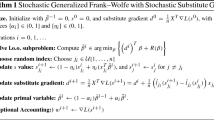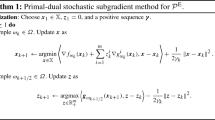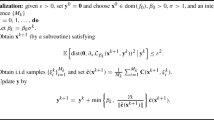Abstract
This paper discusses a stochastic equilibrium problem for which the function is in the form of the expectation of nonmonotone bifunctions and the constraint set is closed and convex. This problem includes various applications such as stochastic variational inequalities, stochastic Nash equilibrium problems, and nonconvex stochastic optimization problems. For solving this stochastic equilibrium problem, we propose an inexact stochastic subgradient projection method. The proposed method sets a random realization of the bifunction and then updates its approximation by using both its stochastic subgradient and the projection onto the constraint set. The main contribution of this paper is to present a convergence analysis showing that, under certain assumptions, any accumulation point of the sequence generated by the proposed method using a constant step size almost surely belongs to the solution set of the stochastic equilibrium problem. A convergence rate analysis of the method is also provided to illustrate the method’s efficiency. Another contribution of this paper is to show that a machine learning algorithm based on the proposed method achieves the expected risk minimization for a class of least absolute selection and shrinkage operator (lasso) problems in statistical learning with sparsity. Numerical comparisons of the proposed machine learning algorithm with existing machine learning algorithms for the expected risk minimization using LIBSVM datasets demonstrate the effectiveness and superior classification accuracy of the proposed algorithm.
Similar content being viewed by others
Code availability
Not applicable.
Notes
In this paper, we sometimes write \(\theta _\xi (\cdot )\) for a functional \(\theta (\cdot ;\xi ) :{\mathbb {R}}^N \rightarrow {\mathbb {R}}\) \((\xi \in { {\Xi }})\).
The sequence \((v_n)_{n\in {\mathbb {N}}} \subset {\mathbb {R}}^N\) is said to be almost surely bounded if \(\sup \{ \Vert v_n\Vert :n\in {\mathbb {N}} \} < +\infty \) holds almost surely [10, (2.1.4)].
When s is sufficiently small, \({\tilde{r}}(w) := \sum _{k=1}^K \omega _k \min \{ \Vert w_{g_k}\Vert , s \Vert w_{g_k}\Vert + (1-s)c \} \approx r(w) := \sum _{k=1}^K \omega _k \min \{ \Vert w_{g_k}\Vert , c \}\) in the sense of the norm of \({\mathbb {R}}\).
The function r defined by (34) is quasiconvex [62, Theorems 4.1 and 4.3] rather than pseudoconvex. Accordingly, we modify \((1/M)((1/2)l_i(w) + r(w))\) with \(\theta _i\) so that F defined by (37) can satisfy the strict pseudomonotonicity condition that is needed to guarantee the almost sure convergence of Algorithm 1 to the solution to Problem 2.1 with F defined by (37) (see Theorem 3.1(iii)).
References
Androulakis, I.P., Maranasand, C.D., Flouda, C.A.: \(\alpha \)BB: a global optimization method for general constrained nonconvex problems. J. Global Optim. 7, 337–363 (1995)
Attouch, H., Bolte, J., Redont, P., Soubeyran, A.: Proximal alternating minimization and projection methods for nonconvex problems: an approach based on the Kurdyka-Lojasiewicz inequality. Math. Oper. Res. 35, 438–457 (2010)
Bauschke, H.H., Borwein, J.M.: On projection algorithms for solving convex feasibility problems. SIAM Rev. 38, 367–426 (1996)
Bauschke, H.H., Combettes, P.L.: Convex Analysis and Monotone Operator Theory in Hilbert Spaces. Springer, New York (2011)
Bauschke, H.H., Goebel, R., Lucet, Y., Wang, X.: The proximal average: basic theory. SIAM J. Optim. 19, 766–785 (2008)
Bento, G.C., Cruz Neto, J.X., Lopes, J.O., Soares Jr., P.A., Soubeyran, A.: Generalized proximal distances for bilevel equilibrium problems. SIAM J. Optim. 26, 810–830 (2016)
Bertsekas, D.P., Nedić, A., Ozdaglar, A.E.: Convex Analysis and Optimization. Athena Scientific, Belmont (2003)
Bianchi, M., Schaible, S.: Generalized monotone bifunctions and equilibrium problems. J. Math. Anal. Appl. 90, 31–43 (1996)
Blum, E., Oettli, W.: From optimization and variational inequalities to equilibrium problems. The Mathematics Student 63, 123–145 (1994)
Borkar, V.S.: Stochastic Approximation: A Dynamical Systems Viewpoint. Cambridge University Press, Cambridge (2008)
Borwein, J.M., Lewis, A.S.: Convex Analysis and Nonlinear Optimization: Theory and Examples, 2nd edn. Springer, New York (2000)
Chang, C.C., Lin, C.J.: LIBSVM: A library for support vector machines. ACM Transactions on Intelligent Systems and Technology 2, 27:1–27:27 https://www.csie.ntu.edu.tw/~cjlin/libsvmtools/datasets/ (2011)
Chen, X., Pong, T.K., Wets, R.J.B.: Two-stage stochastic variational inequalities: an ERM-solution procedure. Math. Program. 165, 71–111 (2017)
Chen, X., Sun, H., Wets, R.J.B.: Regularized mathematical programs with stochastic equilibrium constraints: estimating structural demand models. SIAM J. Optim. 25, 53–75 (2015)
Chen, Y., Lan, G., Ouyang, Y.: Accelerated schemes for a class of variational inequalities. Math. Program. 165, 113–149 (2017)
Cheung, Y., Lou, J.: Proximal average approximated incremental gradient descent for composite penalty regularized empirical risk minimization. Mach. Learn. 106, 595–622 (2017)
Combettes, P.L., Hirstoaga, S.A.: Equilibrium programming in Hilbert spaces. J. Nonlinear Convex Anal. 6, 117–136 (2005)
Crespi, G.P., Guerraggio, A., Rocca, M.: Minty variational inequality and optimization: scalar and vector case. In: Eberhard, A., Hadjisavvas, N., Luc, D.T. (eds.) Generalized Convexity, Generalized Monotonicity and Applications. Nonconvex Optimization and Its Applications, vol. 77. Springer, Boston (2005)
Crespi, G.P., Rocca, M.: Minty variational inequalities and monotone trajectories of differential inclusions. J. Inequal. Pure Appl. Math. 5, 48 (2004)
Facchinei, F., Kanzow, C.: Penalty methods for the solution of generalized Nash equilibrium problems. SIAM J. Optim. 20, 2228–2253 (2010)
Facchinei, F., Pang, J.S.: Finite-Dimensional Variational Inequalities and Complementarity Problems I. Springer, New York (2003)
Facchinei, F., Pang, J.S.: Finite-Dimensional Variational Inequalities and Complementarity Problems II. Springer, New York (2003)
Fan, L., Liu, S., Gao, S.: Generalized monotonicity and convexity of non-differentiable functions. J. Math. Anal. Appl. 279, 276–289 (2003)
Floudas, C.A., Visweswaran, V.: A global optimization algorithm (GOP) for certain classes of nonconvex NLPs: I. Theory. Computers and Chemical Engineering 14, 1397–1417 (1990)
Fukushima, M., Pang, J.S.: Some feasibility issues in mathematical programs with equilibrium constraints. SIAM J. Optim. 8, 673–681 (1998)
Gao, D.Y.: Canonical duality theory and solutions to constrained nonconvex quadratic programming. J. Global Optim. 29, 377–399 (2004)
Ghadimi, S., Lan, G.: Optimal stochastic approximation algorithms for strongly convex stochastic composite optimization I: a generic algorithmic framework. SIAM J. Optim. 22, 1469–1492 (2012)
Ghadimi, S., Lan, G.: Optimal stochastic approximation algorithms for strongly convex stochastic composite optimization II: shrinking procedures and optimal algorithms. SIAM J. Optim. 23, 2061–2089 (2013)
Goebel, K., Kirk, W.A.: Topics in Metric Fixed Point Theory. Cambridge Studies in Advanced Mathematics. Cambridge University Press, Cambridge (1990)
Goebel, K., Reich, S.: Uniform Convexity, Hyperbolic Geometry, and Nonexpansive Mappings. Dekker, New York (1984)
Hastie, T., Tibshirani, R., Wainwright, M.: Statistical Learning with Sparsity: The Lasso and Generalizations. Chapman and Hall/CRC, Boca Raton (2015)
Iiduka, H.: Fixed point optimization algorithm and its application to power control in CDMA data networks. Math. Program. 133, 227–242 (2012)
Iiduka, H.: Iterative algorithm for triple-hierarchical constrained nonconvex optimization problem and its application to network bandwidth allocation. SIAM J. Optim. 22, 862–878 (2012)
Iiduka, H.: Stochastic fixed point optimization algorithm for classifier ensemble. IEEE Trans. Cybern. 50, 4370–4380 (2020)
Iusem, A.N., Jofré, A., Oliveira, R.I., Thompson, P.: Extragradient method with variance reduction for stochastic variational inequalities. SIAM J. Optim. 27, 686–724 (2017)
Iusem, A.N., Sosa, W.: Iterative algorithms for equilibrium problems. Optimization 52, 301–316 (2003)
Iusem, A.N., Sosa, W.: New existence results for equilibrium problems. Nonlinear Anal. Theory Methods Appl. 52, 621–635 (2003)
Karamardian, S.: Complementarity problems over cones with monotone and pseudomonotone maps. J. Optim. Theory Appl. 18, 445–454 (1976)
Kinderlehrer, D., Stampacchia, G.: An Introduction to Variational Inequalities and Their Applications. Classics Appl. Math. 31. SIAM, Philadelphia (2000)
King, A., Rockafellar, R.: Asymptotic theory for solutions in statistical estimation and stochastic programming. Math. Oper. Res. 18, 148–162 (1993)
Kraft, D.: A software package for sequential quadratic programming. Tech. rep., DFVLR-FB 88-28, DLR German Aerospace Center–Institute for Flight Mechanics, Koln, Germany (1988)
Lamm, M., Lu, S., Budhiraja, A.: Individual confidence intervals for solutions to expected value formulations of stochastic variational inequalities. Math. Program. 165, 151–196 (2017)
Liu, Y., Xu, H.: Entropic approximation for mathematical programs with robust equilibrium constraints. SIAM J. Optim. 24, 933–958 (2014)
Lu, Z., Li, X.: Sparse recovery via partial regularization: models, theory, and algorithms. Math. Oper. Res. 43, 1290–1316 (2018)
Luo, Z.Q., Pang, J.S., Ralph, D.: Mathematical Programs with Equilibrium Constraints. Cambridge University Press, Cambridge (1996)
Nash, J.F.: Equilibrium points in \(n\)-person games. Proc. Nat. Acad. Sci. 36, 48–49 (1950)
Nash, J.F.: Non-cooperative games. Ann. Math. 54, 286–295 (1951)
Nedić, A., Lee, S.: On stochastic subgradient mirror-descent algorithm with weighted averaging. SIAM J. Optim. 24, 84–107 (2014)
Nemirovski, A., Juditsky, A., Lan, G., Shapiro, A.: Robust stochastic approximation approach to stochastic programming. SIAM J. Optim. 19, 1574–1609 (2009)
Nocedal, J., Wright, S.J.: Numerical Optimization. Springer Series in Operations Research and Financial Engineering, 2nd edn. Springer, New York (2006)
Ortega, J.M., Rheinboldt, W.C.: Iterative Solution of Nonlinear Equations in Several Variables. Academic Press, Amsterdam (1970)
Pang, J.S., Sen, S.E., Shanbhag, U.V.: Two-stage non-cooperative games with risk-averse players. Math. Program. 165, 235–290 (2017)
Ravat, U., Shanbhag, U.V.: On the existence of solutions to stochastic quasi-variational inequality and complementarity problems. Math. Program. 165, 291–330 (2017)
Robbins, H., Monro, S.: A stochastic approximation method. Ann. Math. Stat. 22, 400–407 (1951)
Rockafellar, R.T., Wets, R.J.B.: Variational Analysis. Springer, Berlin (2010)
Saigal, R.: Extension of the generalized complementarity problem. Math. Oper. Res. 1, 260–266 (1976)
Shalev-Shwartz, S., Singer, Y., Srebro, N., Cotter, A.: Pegasos: Primal estimated sub-gradient solver for SVM. Math. Program. 127, 3–30 (2011)
Shanbhag, U.V., Pang, J.S., Sen, S.: Inexact best-response schemes for stochastic Nash games: Linear convergence and iteration complexity analysis. In: 2016 IEEE 55th Conference on Decision and Control (CDC), pp. 3591–3596 (2016)
Shapiro, A., Dentcheva, D., Ruszczyński, A.: Lectures on Stochastic Programming: Modeling and Theory. MOS-SIAM Series on Optimization, 2nd edn. SIAM, Philadelphia (2014)
Sundhar Ram, S., Nedić, A., Veeravalli, V.V.: Incremental stochastic subgradient algorithms for convex optimization. SIAM J. Optim. 20, 691–717 (2009)
Sundhar Ram, S., Nedić, A., Veeravalli, V.V.: Distributed stochastic subgradient projection algorithms for convex optimization. J. Optim. Theory Appl. 147, 516–545 (2010)
Suzuki, S.: Quasiconvexity of sum of quasiconvex functions. Linear Nonlinear Anal. 3, 287–295 (2017)
Tada, A., Takahashi, W.: Weak and strong convergence theorems for a nonexpansive mapping and an equilibrium problem. J. Optim. Theory Appl. 133, 359–370 (2007)
Takahashi, W.: Nonlinear Functional Analysis. Yokohama Publishers, Yokohama (2000)
Vapnik, V.N.: Statistical Learning Theory. Wiley, Canada (1998)
Wang, M., Bertsekas, D.P.: Stochastic first-order methods with random constraint projection. SIAM J. Optim. 26, 681–717 (2016)
Xu, H., Ye, J.J.: Necessary optimality conditions for two-stage stochastic programs with equilibrium constraints. SIAM J. Optim. 20, 1685–1715 (2010)
Xu, Y., Lin, Q., Yang, T.: Accelerated stochastic subgradient methods under local error bound condition. arXiv, https://arxiv.org/abs/1607.01027
Yao, J.C.: Multi-valued variational inequalities with \({K}\)-pseudomonotone operators. J. Optim. Theory Appl. 83, 391–403 (1994)
Yousefian, F., Nedić, A., Shanbhag, U.V.: On smoothing, regularization, and averaging in stochastic approximation methods for stochastic variational inequality problems. Math. Program. 165, 391–431 (2017)
Zhang, T.: Analysis of multi-stage convex relaxation for sparse regularization. J. Mach. Learn. Res. 11, 1081–1107 (2010)
Zhou, Z.H.: Ensemble Methods: Foundations and Algorithms. Chapman and Hall, Boca Raton (2012)
Acknowledgements
I am sincerely grateful to Editor-in-Chief Sergiy Butenko and the two anonymous reviewers for helping me improve the original manuscript. I also thank Kazuhiro Hishinuma for his input on the numerical examples.
Author information
Authors and Affiliations
Corresponding author
Ethics declarations
Conflict of interest
The author declares that he has no conflict of interest.
Additional information
Publisher's Note
Springer Nature remains neutral with regard to jurisdictional claims in published maps and institutional affiliations.
This work was supported by JSPS KAKENHI Grant Number JP18K11184.
Rights and permissions
About this article
Cite this article
Iiduka, H. Inexact stochastic subgradient projection method for stochastic equilibrium problems with nonmonotone bifunctions: application to expected risk minimization in machine learning. J Glob Optim 80, 479–505 (2021). https://doi.org/10.1007/s10898-020-00980-2
Received:
Accepted:
Published:
Issue Date:
DOI: https://doi.org/10.1007/s10898-020-00980-2
Keywords
- expected risk minimization
- least absolute selection and shrinkage operator
- nonconvex stochastic optimization
- nonmonotone bifunction
- stochastic equilibrium problem
- stochastic variational inequality
- stochastic subgradient projection method




